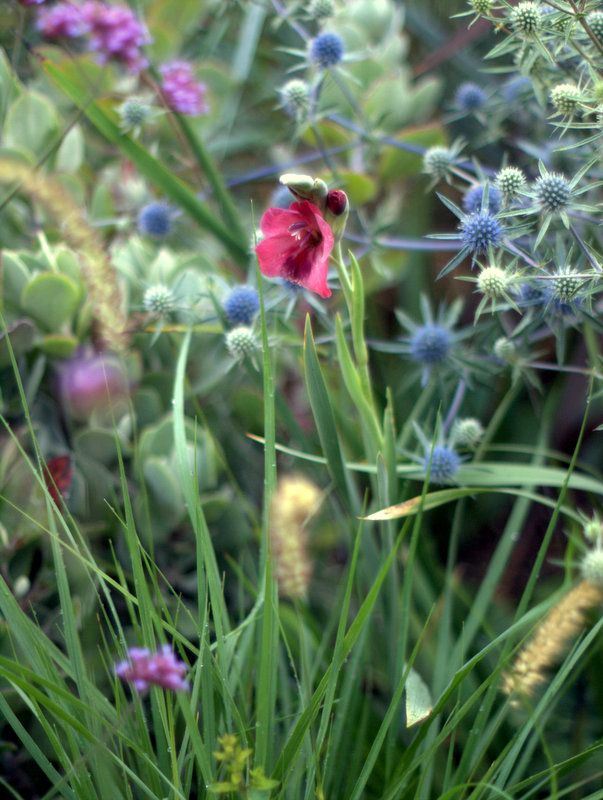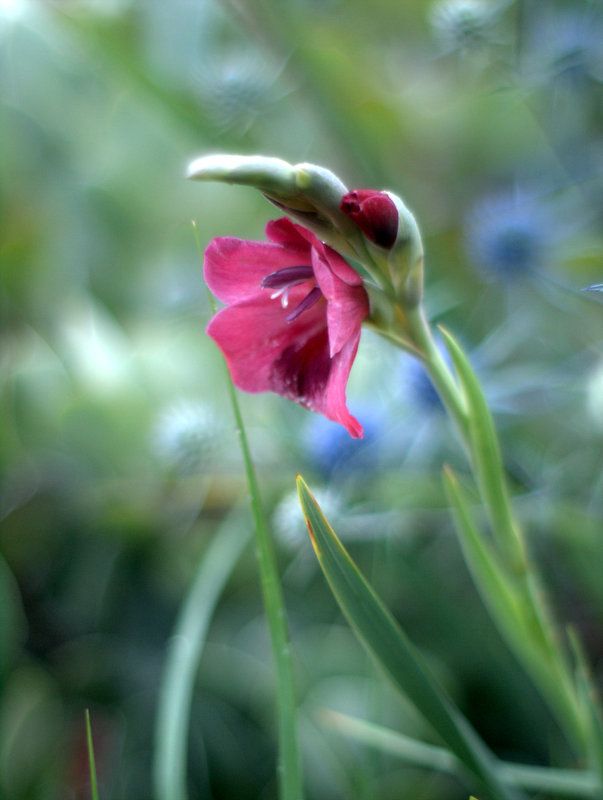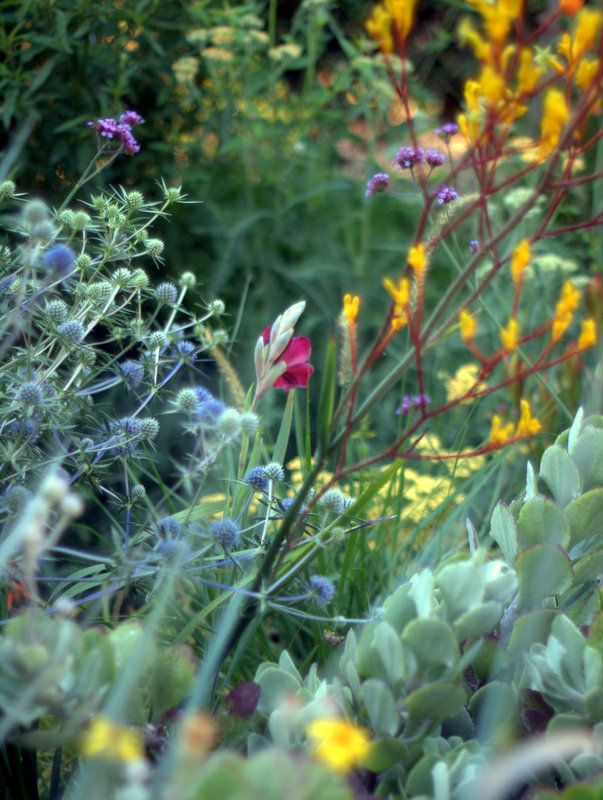I’ll tell you the same story I told Marty before work this morning, when he caught me around sunrise, barefoot and still in pajamas, crouching in the garden, snapping away with the camera. Back in March of 2014, I sent off a terse but plaintive e-mail to Sue Mann of Priory Plants in the UK:
“Just wondering if your nursery ships bulbs to the U.S. — specifically, Gladiolus ‘Ruby,’ which currently has no source in the U.S. Thanks for your help.”
With Sue’s cheerful and steady cooperation, the bulbs were in my hands on April 2, 2014. I immediately planted them in the garden, which was absolutely the wrong thing to do. The garden seemingly ate them for lunch, and there was no further sign of my precious gladioli. Until spring 2016. In hindsight, I know now to always pot up rare little bulbs and corms while they make size and multiply.
This spring I noticed some bulb foliage that seemed a bit more substantial than all the ipheion, sparaxis, and other little bulbs that have accumulated over the years. Instantly I realized that these leaves could very well belong to ‘Ruby.’ A tense vigil over several months ensued while I waited for a sign. A couple of days ago a sliver of red gleamed through the tight flower bud, and identification was confirmed. Bulbs truly are among the most resilient of life forms.

So what’s the big deal, you ask? ‘Ruby’ is a hybrid of the South African species Gladiolus papilio, which has a tall, purply-brown flower with grassy leaves. Coming from South Africa, the species glads are a natural choice for Los Angeles’ similar climate and won’t need chilling like many of the more traditional garden bulbs do. (As it turns out, though, ‘Ruby’ is said to be hardy if mulched well.) I’ve tried a few species gladioli and never really fell in love…until I saw photos of ‘Ruby.’ I think it was one of Dan Pearson’s top picks in an article in Gardens Illustrated.

She’s got it all — great proportions (flowers not too big/not too small), graceful bearing, good height, strong stems, rich color. From another UK nursery, Broadleigh Bulbs: “It combines the depth of colour of a modern hybrid with the growth habit of its species parent.”

I want about 50 more this instant, but that’s not going to happen any time soon.

Moving plants around as I constantly do, ‘Ruby’ ended up in quite a crowded spot. I’d much rather see her in a less tumultuous setting. It might be best to lift the corms in the fall and move them to the safety of a pot, where they’ll hopefully increase into dozens more. And very soon, please. Warm thanks again to Sue Mann of Priory Plants for going to all that trouble to send me a few corms, which I promptly lost, then despite the odds, found again.
P.S. 6/20/16 — I promised to send photos to Sue when ‘Ruby’ bloomed, and this is her response:
“I am so glad they survived for you. Once they get going, they multiply quite quickly, and in fact, I think they will probably grow better in your climate than they do here!. I have just been potting up some more today. When I get a lot of little corms, which are too small to put out into the garden, I plant them in old polystyrene fish boxes, which are about 14″ x 9″ x 6″ deep. Quite gritty soil – after about 6-8months of growing on, they are ready to be potted up into individual pots, or out into the garden. When they are in flower, they are instant sellers! I’m going to a plant fair on the 19 July, so they should be on flower for then.”

I might have to add that to my ‘Diggin dog’ order !
Linda, I know Far Reaches Farm in Oregon carries it from time to time but were out when I was looking around. I think DD carries the species G. papilio. If they do carry ‘Ruby’ I’d say go for it!
I’m glad that ‘Ruby’ came through for you. Bulb blooms always seem like minor miracles to me but a reappearance after 2 years is even more remarkable.
I’m fond of these diminutive species-ish Glads, I had a white one many years back and don’t even remember where I got it. Glads are so good in our climate,we need to embrace them-not all are that yukky salmon number that seems to pop up everywhere.
I can see why this was the one you fell in love with. That’s a great color!
That is a beautiful glad, much more elegant than the ordinary monsters. Perfectly photographed, too. Hope you are staying comfortable in this horrific heat.
@Kris, ain’t it the truth about the minor miracle?
@Kathy, I definitely had the embrace-them-all feeling but couldn’t find any to love. Sue Mann sent photos of some other beauties too.
@Alison, the color is as good as the first photo I saw, no photoshopping involved.
@Hoov, I can’t stand the way those hybrids always lean. I’m a born picture straightener…
‘Ruby’ seems truly a small wonder, and currently stands near the top of the list of garden desiderata for me.
Just wondering, are you willing to share details on your experience interacting with the regulatory powers that be when importing bulbs into the U.S.? I’ve done small lots of seed any number of times with fairly minimal hassle and reasonably good success, but I’ve never quite had the nerve (or guts, or other requisite body part…) to give it a go with bulbs from the U.K. or beyond.
Many kind thanks in advance for your thoughts on it.
MG, as you say seed has always been no problem, yet recently when I was visiting Special Plants, Derry Watkin’s nursery, staff there said the situation was in flux, and they were worried they’d no longer even be able to sell seed to the U.S. So I hesitate to advise you at this point! As my post says, I literally begged some corms from Sue Mann at Priory Plants approx 4 years ago — not sure even begging would work now! When ‘Ruby’ is up in summer I’ll see how many corms have multiplied, so I can share this treasure with others so we don’t lose it forever on this side of the Atlantic.